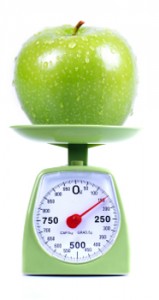 By Delia Quigley for Care2.com
By Delia Quigley for Care2.com
Want to lose weight, keep weight in check, eat just enough to nourish and strengthen your body? Then keeping your meals to the proper serving size is the way to go. But, if serving sizes are important why have meal portions gotten so much larger? One reason is that restaurants and food manufacturers have used “size” as an incentive to lure customers to buy their products and people have responded with a bit too much enthusiasm. More is always better in our culture and that is never truer than with portions of food. Portion size is not to be confused with the recommended serving size of a particular food group. The American meal portions have grown in proportion to our waistlines, but the recommended serving sizes have remained unchanged.
1. Why a serving size?
Because no one food group can provide all the nutrients our body needs. Eating a variety of whole foods, while following the serving size recommendations, helps us obtain our daily allotment of nutrients. These include our daily intake of protein, carbohydrates, fats, vitamins and minerals. Knowing the right serving size also allows you to determine the proper amount of fat and calories your body receives from a meal, which helps you design a healthy lifestyle and exercise regimen.
2. Size of Your Stomach
There is also the size of your stomach muscle to consider. The large sized portions served in restaurants and the increase of dinner plate size from 10 to 12 inches would have you believe that the stomach is one huge organ. In fact your stomach is about the size of your hand closed into a fist when empty, but expands to a fully stretched out hand when full, which can max at about 1.5 liters of food or 6.34 cups. Ideally, you want to stop eating when you are 80 percent full to allow room for digestion to occur. And most important of all is to chew your food thoroughly.
3. Your Hand As a Reference
For a quick reference, stretch out your hand and eat the size of your palm as protein, the size of your hand from wrist to tips of all 5 fingers as carbohydrates in the form of vegetables and whole grains, and your thumb as a measurement for oil, about one tablespoon. Depending on your body size and lifestyle you can safely eat 3-5 meals a day, consisting of a variety of food groups, of this size.
4. As Nature Intended
Eating 5 or more servings of vegetables a day can seem like a lot until you realize that a serving size for vegetables is half a cup and 5 cups worth equals only 21/2 cups. That’s the size of a fresh green salad with a side of broccoli and carrots. Not very much when you consider the amount of sliced pizza you had for last night’s dinner. Nuts are another hot topic, because some unsympathetic food scientist made 6 almonds or 6 walnuts a serving size. However, a quarter cup of almonds (about 12) weighs in at 206 calories and almost 20 grams of fat. Now, if you had to crack and shell those almonds you would be done after the requisite six. Something to remember when serving seeds and nuts is always count or measure out what you need and put the rest away or you will soon be wearing them on your hips and thighs.
5. Serving Size Suggestions
Keep a half-cup measure on your counter for the next week and use to serve your meals. This helps you see just what a half-cup serving of food looks like for future reference.
Follow the serving size recommendations and enjoy a wide variety of whole foods and notice how you feel after a few weeks.
Use the following list to get you started:
- ½ cup cooked whole grains or pasta
- 1-cup cereal
- 1 slice of bread
- ½ bagel
- 1 piece of fresh fruit
- ¼ cup dried fruit
- ¾ cup fruit juice
- ½ cup fresh vegetables
- ½ cup beans or legumes
- 3-4 ounces animal protein (poultry, fish, meat)
- 1 egg
- 1-tablespoon nut butter
- 6 almonds or 12 walnut halves
- 2 teaspoons pumpkin, sunflower or sesame seeds
- ½ cup tofu or tempeh
- 1-teaspoon miso
- 1-cup non-dairy or dairy milk
- ½ cup ice cream or frozen dessert
